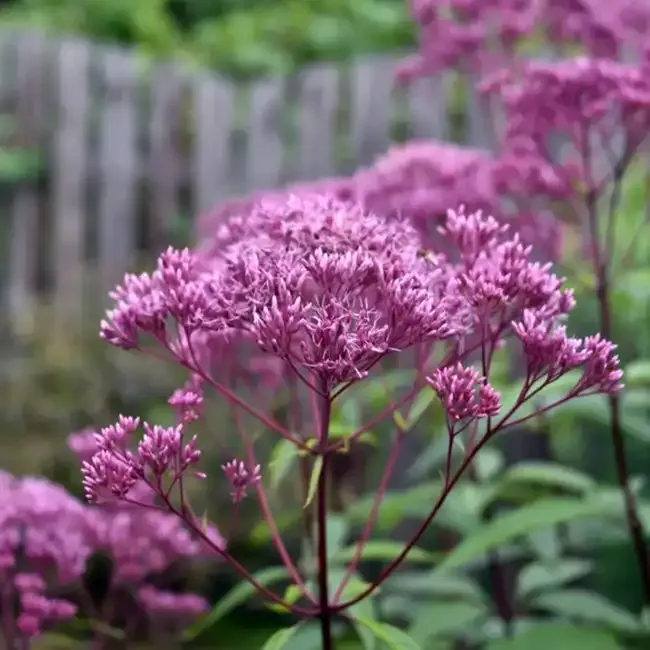
Joe Pye Weed is a perennial wildflower native to North America. It is a tall plant with clusters of fluffy, lavender-pink blooms. Its adaptability, resilience, and ability to thrive in various garden conditions have made it a valuable addition to pollinator gardens. Joe Pye Weed is a late-season bloomer that provides nectar when other flowers have faded, attracting bees, butterflies, and hummingbirds to your garden.
Pollinator Attractor
One of the primary reasons gardeners love Joe Pye Weed is its ability to attract a wide array of pollinators. Monarch butterflies, swallowtails, bees, and hummingbirds flock to its flowers, making it an essential plant supporting pollinator populations.
Monarch butterflies rely on late-season nectar plants like Joe Pye Weed to fuel their long migrations. Including Joe Pye Weed in your garden provides essential sustenance for these and other vital species when food sources are scarce.
Late-Season Bloomer
Joe Pye Weed blooms from late summer through early fall, making it an excellent choice for a pollinator-friendly garden. The tall, airy flower heads stand atop 4-7 foot stems, adding visual interest and texture. Its soft pink and lavender tones complement other late-season bloomers, such as asters and goldenrod, creating a harmonious garden design.
The flowers also hold well into fall, even after their bloom fades, contributing to winter interest in the garden as the seed heads remain standing.
Perennial Nature
As a perennial, Joe Pye Weed will return year after year, making it a long-term investment in your garden's beauty and biodiversity. Joe Pye Weed is hardy in USDA zones 4-9 and requires minimal maintenance once established. In addition to its longevity, it is deer-resistant and thrives in moist to wet soils, making it a perfect choice for rain gardens, low-lying areas, and borders near streams or ponds.
Growing Tips
- Location and Soil: Joe Pye Weed thrives in full sun to partial shade. It prefers moist, rich soil, though it will tolerate average garden soil as long as it doesn't dry out completely. It's ideal for areas with consistent moisture, such as along garden edges, in rain gardens, or beside ponds.
- Watering: Joe Py weed prefers moist soil. Mulching around the base of the plant can help retain moisture.
- Spacing: These plants can grow tall, reaching 4-7 feet, and may spread up to 3 feet wide. Be sure to give them ample space to grow without being crowded.
- Fertilizing: Joe Pye Weed doesn't require heavy feeding—an annual application of compost or a slow release.
- Support: Due to its height, it may benefit from staking in windy or exposed areas. Otherwise, the sturdy stems usually hold up well on their own.
- Cutting Back: After the first frost, you can cut back the dead stems to tidy up the garden. Alternatively, you can leave the stems standing for winter interest and wildlife support, as the seed heads provide bird food.
- Propagation: Joe Pye Weed can be propagated by division in early spring or fall or by collecting seeds from the mature flower heads. The division is an effective method of controlling its size and spread.
For several reasons, Joe Pye Weed is a great plant to add to your garden landscape. It offers late-season blooms and essential nectar for a variety of pollinators. Because it is tall, it is best planted in the back of the garden bed.
